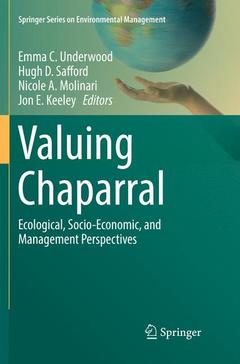Valuing Chaparral, Softcover reprint of the original 1st ed. 2018 Ecological, Socio-Economic, and Management Perspectives Springer Series on Environmental Management Series
Coordonnateurs : Underwood Emma C., Safford Hugh D., Molinari Nicole A., Keeley Jon E.

Chaparral shrubland ecosystems are an iconic feature of the California landscape, and a highly biodiverse yet highly flammable backdrop to some of the fastest growing urban areas in the United States. Chaparral-type ecosystems are a common element of all of the world?s Mediterranean-type climate regions ? of which California is one ? yet there is little public appreciation of the intrinsic value and the ecosystem services that these landscapes provide. Valuing Chaparral is a compendium of contributions from experts in chaparral ecology and management, with a focus on the human relationship with chaparral ecosystems. Chapters cover a wide variety of subjects, ranging from biodiversity to ecosystem services like water provision, erosion control, carbon sequestration and recreation; from the history of human interactions with chaparral to current education and conservation efforts; and from chaparral restoration and management to scenarios of the future under changing climate, land use, and human population. Valuing Chaparral will be of interest to resource managers, the research community, policy makers, and the public who live and work in the chaparral dominated landscapes of California and other Mediterranean-type climate regions.
Foreword
Preface
Acknowledgments
Chapter 1 California Chaparral and its Global Significance
Chapter 2 Drivers of Chaparral Plant Diversity
Chapter 3 Faunal Diversity in Chaparral Ecosystems
Chapter 4 Native Peoples’ Relationship to the California Chaparral
Chapter 5. Essential Landscape: An Environmental History of Chaparral Ecosystems in California
Chapter 6 Biogeochemical Cycling of Carbon and Nitrogen in Chaparral Dominated Ecosystems
Chapter 7 Sediment Delivery, Flood Control, and Physical Ecosystem Services in Southern California Chaparral Landscapes
Chapter 8 Water Provision in Chaparral Landscapes – Water Quality and Water Quantity
Chapter 9 Mapping the Value of National Forest Landscapes for Ecosystem Service Provision
Chapter 10 Recreation Ecosystem Services from Chaparral Dominated Landscapes: A Baseline Assessment from Nationa
l Forests in Southern CaliforniaChapter 11 Connecting Californians with the Chaparral
Chapter 12 Chaparral Landscape Conversion in Southern California
Chapter 13 Chaparral Restoration
Chapter 14 Climate Change Trends for Chaparral
Chapter 15 Managing Chaparral Resources on Public Lands
Summary Chapter: The Past, Present, and Future of California Chaparral
Contributors
Dr. Emma Underwood is a research scientist with the Department of Environmental Science and Policy at the University of California, Davis and is a visiting fellow with Southampton University in the UK. A central theme of her research is the application of geospatial tools and remote sensing techniques to address biodiversity and conservation issues and inform environmental decision-making. Her research interests include conservation assessments of biodiversity, estimating conservation return on investment, evaluating ecosystem services, and mapping and predicting the distribution of invasive plant species. During the past 15 years Emma’s research has spanned a variety of ecosystems including tropical forests and a global conservation assessment of Mediterranean-type climate regions. Prior to UC Davis, she worked for the World Wildlife Fund-US and has since undertaken collaborative research with The Nature Conservancy, the US Geological Survey, and the US Forest Service. Emma received her Ph.D. in Ecology from the University of California.
Dr. Hugh Safford is Regional Ecologist for the USDA Forest Service’s Pacific Southwest Region (California, Hawaii, Pacific territories), and member of the research faculty in the Department of Environmental Science and Policy at the University of California, Davis. Hugh manages a staff of ecologists that provide expertise in vegetation, fire, and restoration ecology, climate change, inventory, and monitoring to the 18 national forests in the Pacific Southwest Region. He is manager of the Regional Research Natural Area program, Sierra Nevada region leader for the California Fire Science Delivery Consortium, and science advisory board member for a number of environmental collaboratives and NGOs. Hugh provides international technical assistance on fire, forest management, and climate change issues in partnership with the US Agency for International Development (USAID) and the International Program of the Forest S
Describes ecosystem services and other values provided by chaparral and similar shrubland ecosystems
Details challenges of fire, climate change, and land conversion for chaparral conservation and management
Provides practical information for managers and policy makers relating to conservation and restoration of chaparral
Date de parution : 12-2018
Ouvrage de 467 p.
15.5x23.5 cm
Date de parution : 04-2018
Ouvrage de 467 p.
15.5x23.5 cm
Thèmes de Valuing Chaparral :
Mots-clés :
Chapparral shrublands; ecosystem services; biodiversity; carbon storage; sediment erosion retention; water quantity; water quality; recreation; flood control; Native American use; habitat conversion; fire return interval; Mediterranean-type climate regions; conservation; natural resources and energy economics



